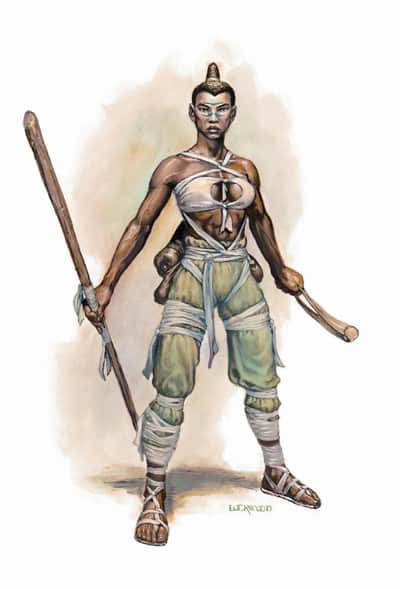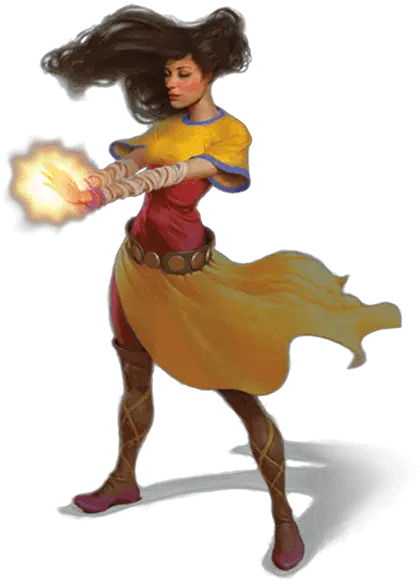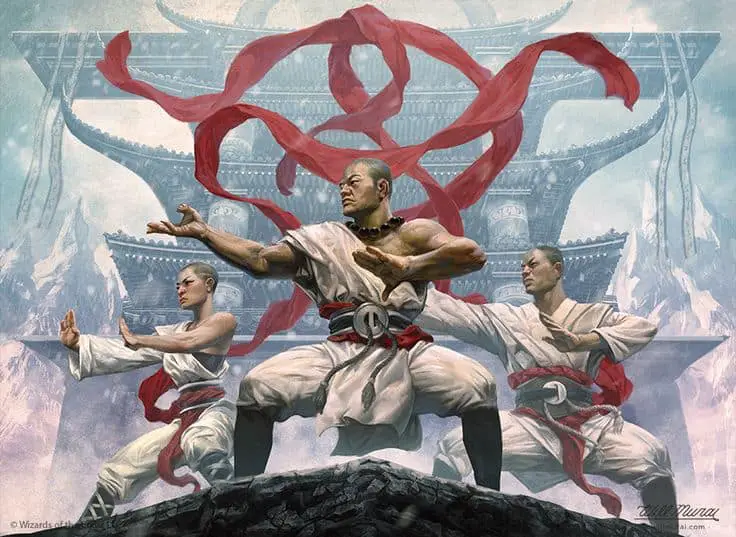With both the tranquility and crashing power of water, the Way of the Open Hand Monk is a master of martial arts.
Whether armed or unarmed, these Monks are a force to behold! They strike swiftly and decisively while using their ki to remain centered and self-sufficient in combat.
Of all of the Monk subclasses, this is the one that is what most immediately comes to most peoples’ minds. For good reason too!
So empty your mind, friend. Measure your breaths and align your ki as we dive into this full guide to the Way of the Open Hand Monk in D&D 5e!
What is the Open Hand Monk in D&D 5e?
As the definitive Monk class archetype, the Way of the Open Hand Monk hits all of the notes that you might expect.
These characters work tirelessly to achieve mastery of the body, mind, and spirit.
Physically, they’re able to strike swiftly while also manipulating enemies’ positioning on the battlefield. Before an enemy knows what hit them, they could find themselves prone on the ground or flying backward from the Monk’s attacks.
The most legendary of these Monks are even said to have the ability to instantly stop an enemy’s heart with only the vibration from their attacks.
While Monks who follow this Monastic Tradition are most commonly unarmed, they are similarly just as powerful when wielding Monk Weapons like a quarterstaff or nunchaku.
Mentally, the Way of the Open Hand Monk trains themselves to achieve a level of balance and tranquility that few others can comprehend. Through practice and discipline, this heightened state serves to protect them from harm.
When necessary, these Monks are even able to channel their ki to heal themselves.
Putting all of this together, you get a Monk subclass that is truly impressive. It has reliable damage output with the ability to disrupt enemies’ positioning while being self-sustainable enough to stay in the fight longer than other Monastic Traditions.
The Way of the Open Hand is one of three Monastic Traditions included in the Player’s Handbook.
Role in the Party
The Way of the Open Hand Monk is all about damage output with some ability to lockdown and control enemies’ positioning. You’re a frontline striker with plenty of talent for controlling the battlefield!
On top of the base features offered by the Monk class, these Monks gain a great deal of survivability as they level up. This means you can play a bit more aggressively with an Open Hand Monk than you might otherwise with another subclass.
The Open Hand Technique feature is particularly useful to this subclass, so you’ll be using your Flurry of Blows feature quite a bit.
Not only is this giving you even more attacks per round, but you can easily set your allies up to pile even more damage on top. (We’ll go over that in more detail in the next section!)
You’re not only a gifted striker with some solid self-sustaining abilities, but you’re also able to offer extra help to the party.
As an unarmored character, you’ll likely attract the focus of enemies who mistake you for an easy target. This helps you take some of the heat off of your squishier party members.
If the party finds itself without a Ranger or Scout Rogue, you’re quick and observant enough to do some recon as well!
Related: Flurry of Blows Explained

Way of the Open Hand Monk Features 5e
We’ve covered what the Open Hand Monk is and their role in the party, now let’s get into the good stuff!
As I mentioned, the Open Hand Monk’s abilities work to help them better control the battlefield while being more self-sustaining as they level up.
These are some of my favorite abilities across all of the Monk subclasses!
Open Hand Technique (Level 3)
When you take the Way of the Open Hand at level 3, you immediately gain the Open Hand Technique feature.
Harnessing the power of your own ki, you’re able to manipulate that of your enemies.
Open Hand Technique is your most important feature from this subclass and buffs the Monk’s Flurry of Blows ability.
As a monk, you can spend one ki point after you take the Attack action on your turn to use Flurry of Blows. This lets you make two unarmed attacks as a bonus action.
With Open Hand Technique, you can add one of the following effects to a creature you hit with one of the attacks you gain from Flurry of Blows:
- They must succeed on a Dexterity saving throw or be knocked prone.
- The creature must succeed on a Strength saving throw or be pushed up to 15 feet away from you.
- The creature can’t take reactions until the end of your next turn.
Note that these saving throws are made against your Ki Save DC. This DC is equal to 8 + your proficiency bonus + your Wisdom modifier.
Knocking an enemy prone is a great way for yourself or other melee attackers to follow up with advantage on their attacks. Your party can absolutely dogpile the enemy once you’ve knocked them down with this!
Pushing the enemy back can give you some interesting opportunities to interact with the environment. You can send the enemy flying off of the ship you’re fighting on or into a trap or hazard.
If you instead want to get some distance, preventing your enemies from taking reactions can let you or your allies move away without fear of an attack of opportunity. Best of all, there’s no save for that option!
Using Open Hand Technique Multiple Times
A pretty common point of confusion is whether or not a Monk can use the Open Hand Technique multiple times. Because this is a passive feature attached to your Flurry of Blows attacks, you can effectively use it twice per turn!
You might choose to hit the same creature with both attacks. So if you smack Gnoll A with the first Flurry of Blows attack, you could choose to stop it from taking reactions. With your second attack, you could choose to send it flying backward 15 feet and into the valley below.
(As a DM, I would say the Gnoll wouldn’t get a save to catch itself from falling because it’s unable to take reactions. Enjoy the falling damage!)
However, you might instead choose to spread the effects around a bit.
Using your Flurry of Blows, you smack Gnoll A and knock it prone. While you could follow up with another attack (at advantage!), you instead decide to smack Gnoll B and knock it prone as well too.
As the rest of your party members’ turns are coming up, they’ll be able to run up and get advantage on their attacks to make quick work of the two Gnolls before dealing with the rest of the pack.
So each of the two attacks you gain from Flurry of Blows can do one of the three effects. You might use the same effect twice or you might mix it up.
Experiment with your options and look for opportunities where some might be better than others!
For example, a Hill Giant will very likely pass its Strength saving throw, but you can probably trip it easily since they have low Dexterity!
Also Check Out: Monk Weapons in D&D 5e Explained
Wholeness of Body (Level 6)
At level 6, you gain the ability to channel your energy in such a way that it can heal your own wounds.
Specifically:
As an action, you can regain hit points equal to three times your Monk level.
You must finish a long rest before you can use this feature again.
This is a relatively simple feature that straddles the line between being really useful and a trap.
On one hand, it’s free healing. You’re healing 18 hp at level 6 when you get this. As you level up, it gets more potent.
However, the “trap” part of this comes down to your action economy.

Using Wholeness of Body Correctly
Monks can do A LOT in a turn.
At this point, your standard turn is taking the Attack action to make two attacks followed by spending a ki point to make two more attacks with Flurry of Blows.
Using Wholeness of Body mid-combat kind of throws a wrench in your typical flow. You’re regaining hit points, but you aren’t really left with a whole lot of other options.
From there, you are probably best spending a ki point to either take the Dodge action with Patient Defense or to Disengage with Step of the Wind.
In all but the direst of situations, it’s probably best to beat the daylights out of your enemy and hopefully drop them while your party’s healer tries to get to you. Otherwise, you might spend your turn healing yourself only to just immediately lose those hit points over again.
*insert sad trombone noises here*
The best use of Wholeness of Body is between combats. If your party doesn’t want to take a short rest or if you don’t have any hit dice left, it’s a great alternative to using up one of your healer’s spell slots.
As with all things involving the Monk class, exercise discipline and wisdom when using this ability. If you’re clever, once per long rest should be plenty useful for you!
Also Check Out: The Full Monk Class Guide for D&D 5e!
Tranquility (Level 11)
At level 11, the Open Hand Monk gains the Tranquility feature.
This one is admittedly a little weird…
At the end of a long rest, you gain the effect of a sanctuary spell that lasts until the start of your next long rest (the spell can end early as normal).
Let’s break this down a bit, shall we?
For a creature to attack you or cast a harmful spell on you, they first have to make a Wisdom saving throw. The DC for this save is 8 + your proficiency bonus + your Wisdom modifier. If they don’t succeed on the saving throw, they have to either choose a new target or lose the attack/spell.
Unless the enemy is throwing an AoE effect at you (like fireball or lightning bolt), this can be a great way to minimize the damage you take.
Unfortunately, the effect of Sanctuary stops if you make an attack, cast a spell that affects an enemy, or deal damage to another creature.
So, you’re just kind of… there…
The three situations where I see this being useful are:
- You rolled low on initiative in your first combat of the day. It’s much less likely that you start your turn missing any hit points and can better start dishing out some knuckle sandwiches.
- Enemies are ambushing your party. They caught you by surprise, but won’t have such an easy time hitting you.
- You’re trying to deal with a hostile NPC in a diplomatic manner. They keep failing their saves to hit you while you spend your turn trying to talk some sense into them.
This isn’t the most impressive of features, but it can be strangely useful in the right situations!

Quivering Palm (Level 17)
Oh boy, oh boy, oh boy!
We’ve finally come to what is possibly the coolest subclass feature in all of D&D: Quivering Palm.
When you hit a creature with an unarmed strike, you can spend 3 ki points to start imperceptible vibrations in the creature’s body which last for a number of days equal to your Monk level.
The vibrations are harmless unless you use an action to end them. To do so, you and the target must be on the same plane of existence.
When you use this action, the creature must make a Constitution saving throw. If it fails, it is reduced to 0 hit points. If it succeeds, it takes 10d10 necrotic damage.
You can only have one creature under the effect of this feature at a time. You can choose to end the vibrations harmlessly without using an action.
This is mind-blowingly awesome. If your enemy fails their save, they die. If they make it, they are still taking upwards of 100 points of necrotic damage which could still mean game over for them.
Keep in mind that the Constitution save for Quivering Palm is 8 + your proficiency bonus + your Wisdom modifier. Don’t ignore increasing your Wisdom score as you level up!
All that for just 3 ki points and two actions! Wow!
Even better, few things are going to bring any reasonably intelligent to heel faster than making it clear what you’ve just done to them with this feature. For 2-3 weeks, they are very motivated to be as nice and compliant with you as they can possibly be.
If you’re trying to gain leverage (if the target is more valuable alive), few things will give you this kind of bonus on an Intimidation or Persuasion check!
Even beyond the damage that Quivering Palm can cause, there are countless options for how you can use it!
The Downsides of Quivering Palm
Okay, so let’s be real: something as crazy powerful as Quivering Palm needs to have some downsides to it.
That said, there are not many!
First and foremost, the enemy is making a Constitution saving throw against this effect. Most enemies (especially at these very high levels) are pretty good at making these saves. That doesn’t mean they won’t fail, but the odds are a bit slimmer.
However, they’ll still take a boatload of damage.
Secondly, it’s incredibly common for big enemies at this level to have legendary resistances that guarantee them a successful save. They’ll still take a ton of damage, though.
If you can, try to bait the enemy into burning their legendary resistances on other effects like your Stunning Strike first!
Last, you can only have one creature at a time affected by Quivering Palm.
You’ll want to choose who you use it on wisely. That said, the vibrations are imperceptible and the creature might just be inclined to still tread carefully if they think there’s even a chance you haven’t safely ended the effect on them!
Related: Mastering the Monk’s Stunning Strike Feature
Is Quivering Palm Magic?
So what exactly is Quivering Palm, though?
Quivering Palm is neither a magical effect (like a spell) nor a curse. As such, its effect can’t be removed with a spell like Dispel Magic or Remove Curse.
Ki is a type of magic in the sense that there’s not really another succinct way to describe what it is. It’s not magic in the way that a Wizard or Cleric might understand.
Instead, ki is a type of energy tied to the very essence of the world around you. It doesn’t go by the same rules that arcane and divine magic does.
Besides, and let’s be honest here, being able to counter a level 17 capstone ability with a level 3 spell would be awful design. I’d probably just rip this class out of my Player’s Handbook if that were the case.
Is Quivering Palm Overpowered?
Quivering Palm is fully capable of instantly killing a powerful creature like an Ancient Dragon or the Tarrasque. If the creature has used all 3 of its legendary resistances, you could potentially one-shot it as an Open Hand Monk.
It’s only natural that some people might fear if this feature is balanced or not!
However, Quivering Palm is not overpowered when you look at the tier of play you’re in when it becomes available. It’s incredibly strong, for sure, but there’s enough working against it to stop it from being broken.
Creatures with high Constitution scores, legendary saves, or necrotic resistance will fair much better against Quivering Palm. In these high levels of play, those aren’t terribly uncommon.
Open Hand Monks of level 18 and higher are able to use Quivering Palm 6 times per short rest. You’re incredibly unlikely to get the full effect of it on your first use against many enemies at this level.
Quivering Palm is MUCH LESS of an “I Win Button” without plenty of teamwork, strategy, and good luck.

Connections
The Way of the Open Hand Monk naturally caters to a type of character that is steeped in tradition.
These characters have learned discipline and martial arts from within the walls of a monastery. They join the party less for the typical goals of gaining gold and more for the goal of seeing the world while developing their abilities.
To follow the Way of the Open Hand is to dedicate oneself fully to the lessons that the tradition teaches. In time, it’s not unlikely for such a character to take an apprentice that they meet on their travels.
When connecting your Open Hand Monk to the game’s world, consider the character’s relationship with their monastery as a starting point. Did they leave willingly or were they asked to leave (for good reasons or otherwise) by their master?
Having spent so much of their life within the monastery’s walls, how do they view and experience the world outside of the monastery?
Does your character approach others in the world with an open mind or do they find others’ lack of discipline disturbing?
As you pursue mastery of both body and mind, what lessons might you learn from your other party members?
Is the Way of the Open Hand Monk Good?
It’s easy to view the Way of the Open Hand Monk in D&D 5e as a type of “default setting.” But, honestly, that view really doesn’t do this subclass justice.
All in all, the Way of the Open Hand Monk is a great option to consider for your character. Whether you’re new to playing a Monk or you have a monastery full of retired Monk character sheets, this subclass is just awesomely fun.
The mixture of damage output and control that the Open Hand Monk has makes them a powerful frontline character.
As long as you make sure to manage your ki points effectively, you’ll have no problem dropping enemies before they even knew what hit them!
See where the Open Hand Monk lands in the full ranking of every Monk subclass in D&D 5e!
Conclusion – Guide to the Open Hand Monk in D&D 5e
I hope you’ve found this guide to the Way of the Open Monk in 5e helpful!
Monks have always been the subject of some strong opinions among D&D players for decades now. Depending on who you ask, they’re either weak and useless or completely overpowered.
But it seems like players are beginning to really warm up to Monks as a class and the Way of the Open Hand just perfectly scratches the itch for all kinds of kung-fu awesomeness!
Hit me up in the comments with any thoughts, questions, or campaign stories you have about Open Hand Monks! I’d love to read what you have to say!
Want all the latest player guides, DM tips, news, reviews, and more for D&D 5e? Sign up for the Tabletop Joab newsletter below!
You can also follow me on Facebook and Twitter.
If you found this article helpful and want to support the site, you can buy me a coffee here! (It’s not expected, but very appreciated!)









